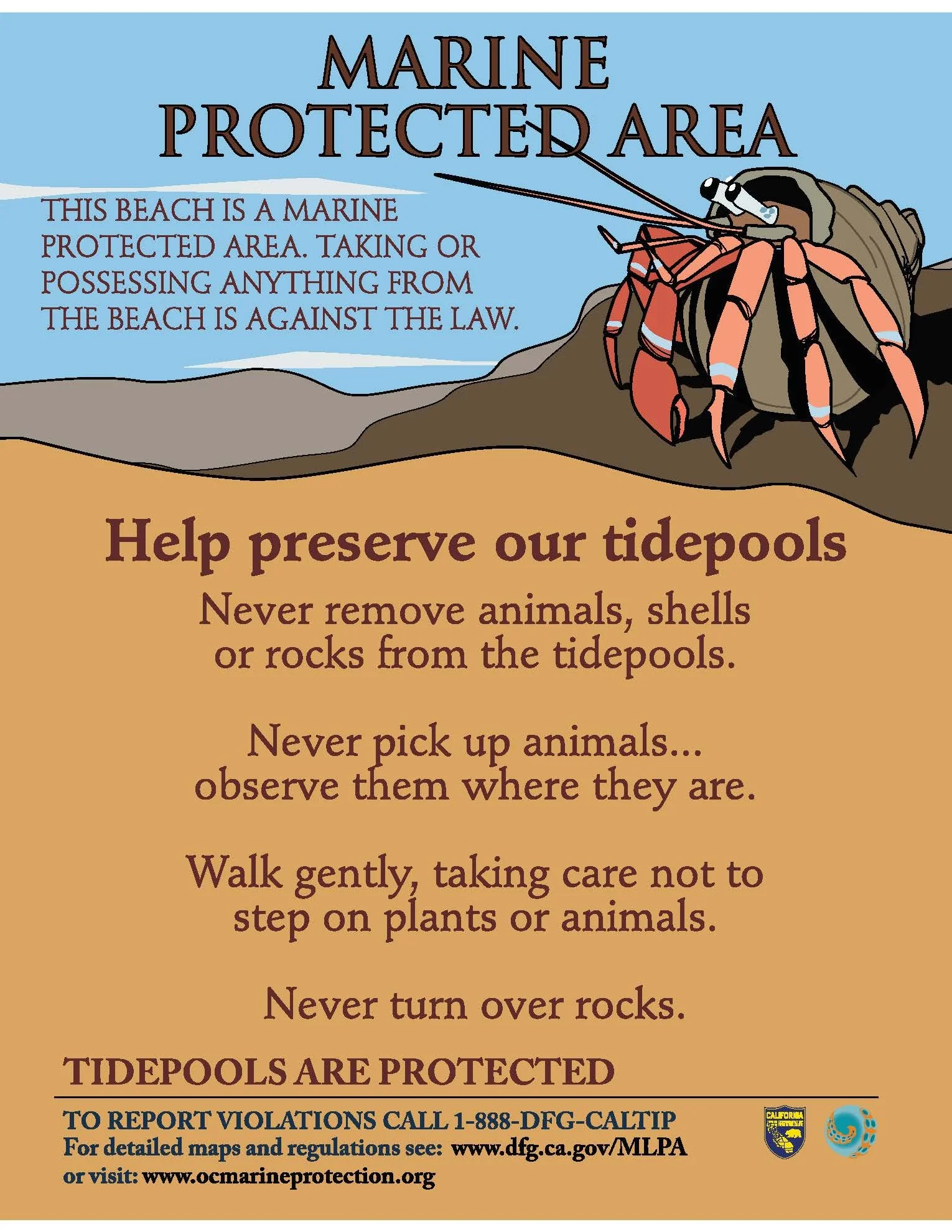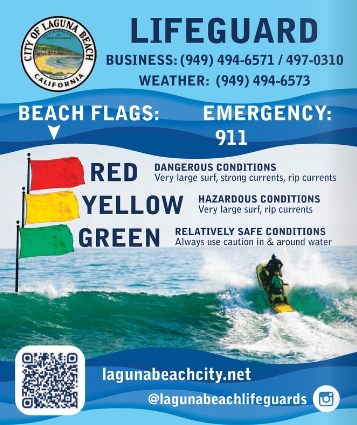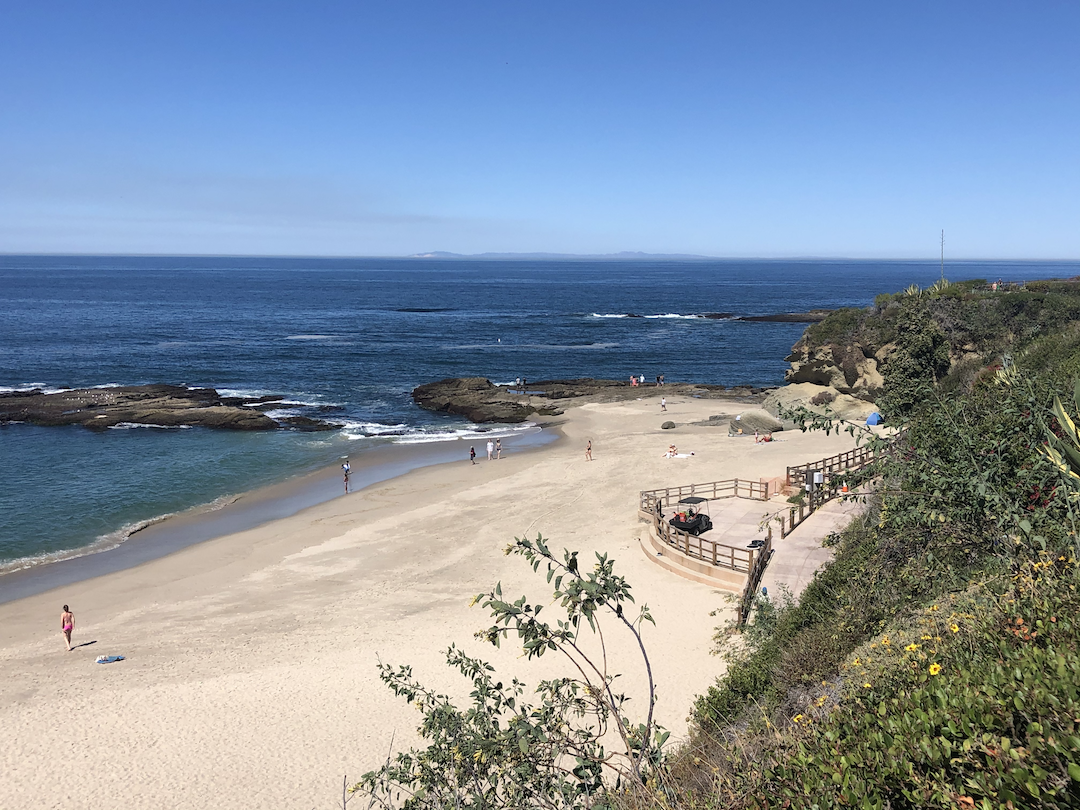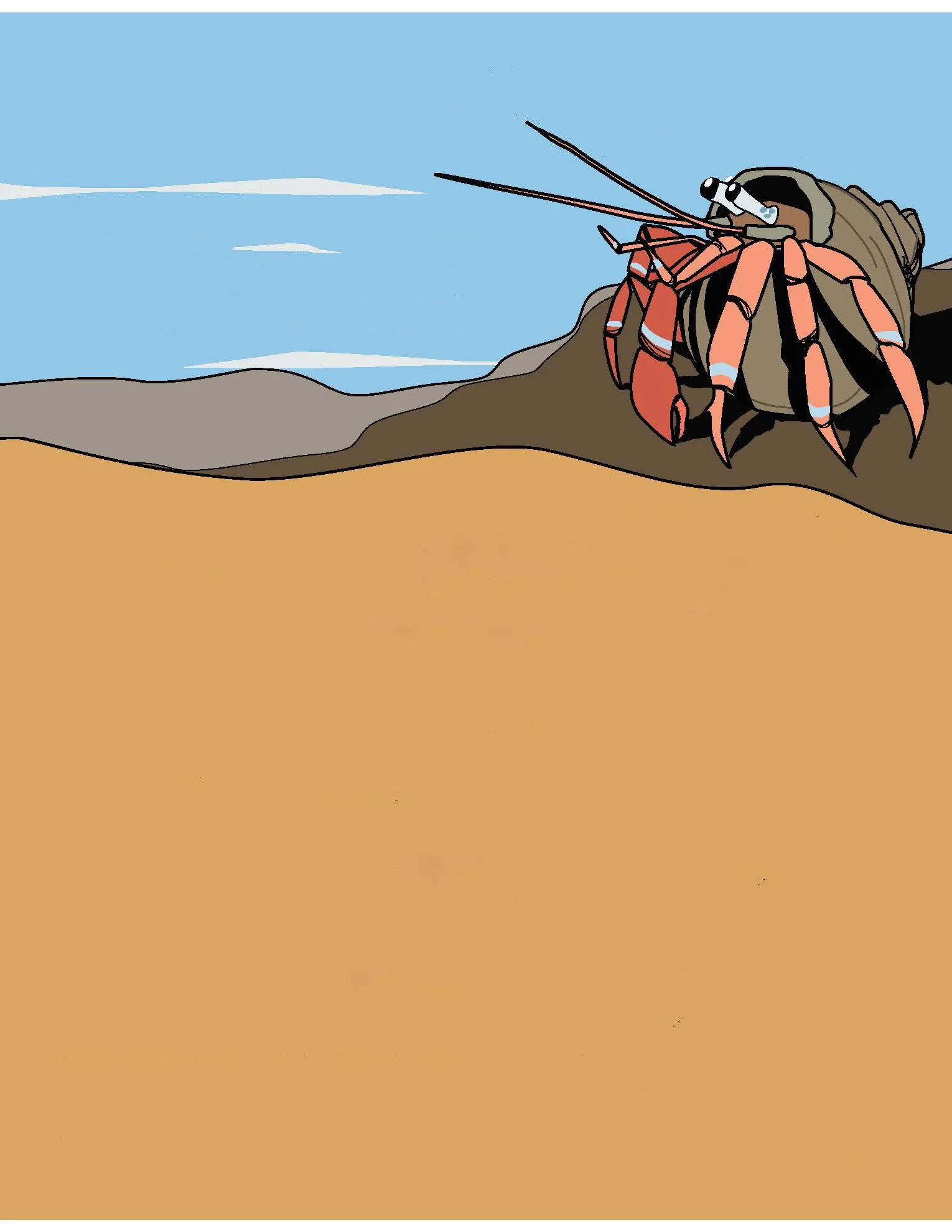
How to Tidepool
Know before you go.
Tidepooling is a fun, family-friendly activity, but we want to make sure you’re prepared to explore ahead of time. Read the information below to help you make an informed decision of when, where, and how to tidepool. Remember, Laguna Beach is a Marine Protected Area and is also protected under the City of Laguna Beach Municipal Code 18.29.030.
When you visit, follow the rules of not causing any harm to the area and not taking any items (animals, algae, plants, shells, or rocks), even in a hand or bucket to look at. To help minimize harm, keep your feet on dry land and look with your eyes only. Want to remember the tidepools forever? Take a picture (or two!) and you’ll always be able to remember the beautiful sites!
City of Laguna Beach Municipal Code 18.29.030 No person shall take, possess or disturb specimens of live or dead intertidal marine animal or plant life, or willfully injure, destroy or alter marine intertidal zone habitats. (Ord. 1470 § 1, 2007). Other laws below (anchor link).
Let’s be good tidepoolers together!
Check out the “good tidepooler” rules put together by the Orange County Marine Protected Area Council. You’ll find these Harry the Crab signs at all beach access points in Laguna Beach. See if you can spot him and say hi each time you visit!
Being a Good Tidepooler means following the rules of the Marine Protected Area as well as safety directions and signs from lifeguards.
• Never remove animals, shells, or rocks from the tidepools.
• Never pick up animals… observe them where they are.
• Walk gently, taking care not to step on plants or animals.
• Never turn over rocks.
To ensure both you and tidepool inhabitants are safe, observe the above tidepooling rules and leave organisms where they are – undisturbed. You’ll be surprised by how many more species you’ll see as you remain still watching the critters come out from hiding!
When should I tidepool?
Tidepooling is best at low tide, especially if it is a negative low tide with little to no surf. We recommend tidepooling when the low tide is below +2.0 ft. High surf can make it difficult and dangerous to tidepool, even during low tide. Always check the surf report and tide calendar before your trip.
Interested in visiting us at one of the eight sites we provide free tidepool education at? Click here to learn more about the sites and use a tidepool map to find the one closest to you!
Understanding Surf Conditions
Surf conditions are determined by weather and water currents and can change quickly. Anytime you come to the beach, we recommend you look at the surf report to make sure it is safe for water and near shore activities. Flags on the Lifeguard tower indicate conditions:
A green flag means favorable conditions
A yellow flag means to be cautious due to conditions such as elevated surf, rip currents, or near shore hazards including things such as sting rays.
A red flag means dangerous conditions and it is recommended to not enter the water or be within the surf zone.
Always obey lifeguard directions and signs. During times of high surf and high tides the lifeguards may put out a “Rocks closed” sign, meaning the tidepool area is too dangerous and tidepooling is not allowed until the sign is removed.
Make sure you come prepared!
Here’s what you should bring with you.
1. Appropriate clothing, especially quick-drying, in case you get wet. A jacket is recommended because it can be cold, even during summer.
2. Appropriate footwear. Bare feet or flip flops are not recommended due to sharp rocks and other hazards. Wearing water shoes, closed-toed sandals, or sneakers is best.
3. Bring sun protection, including a hat, sunglasses, and reef safe sunscreen. We recommend Raw Elements for reef safe sunscreen. Tidepools are on an exposed coastline and there is no refuge from the sun.
4. Water and snacks. Water is available at all restroom locations, but not all tidepool locations have restrooms nearby.
5. Any electronics, like cameras and cell phones, should be waterproof for protection.
6. A first aid kit is recommended for minor injuries. Lifeguards are not available at all locations year-round for these needs.
7. Clothes and shoes may get wet and sandy. Bring a towel to dry or brush off, water to rinse sandy items and feet, extra clothes and shoes to stay dry and comfortable, and a bag to place wet clothes and shoes in for your transport home.
Watch your step!
Tidepooling is a fun and family-friendly activity but there are safety risks, including slippery rocks and crashing waves. The most important rule is to be aware of your surroundings and to never turn your back to the ocean. It is also required to follow all lifeguard instructions and signage. We recommend that you do not run in the tidepools. You are more likely to trip and seriously injure yourself running away from a wave than standing your ground and getting wet.
To access tidepools you can use your own mode of transportation, ride-share, or public transportation, like the Orange County Transportation Authority bus or Laguna Beach public (FREE) trolley. There is also a “Laguna Beach Parking” mobile phone app that can be downloaded onto any smartphone to assist you in finding and paying for parking.
Once at the proper location, there are most often stairs, a ramp, or both to go from the bluff to the beach. For more information on ADA compliant beach access, including beach wheelchairs, please contact Laguna Beach Marine Safety at (949) 494-6572.
When parking in residential neighborhoods, we encourage you to be a good neighbor by making sure you park respectfully (not blocking driveways, gates, or access points). Also, it is highly recommended to follow all street signs, including parking day and time limits, as well as colored curbs.
FAQs
What can I see?
Visit our page dedicated to tidepool species and what you can expect to see. Want a hard copy to print out for your next visit? Download the Tidepool Explorer Guide created by Orange County Marine Protected Area Council.
What can I take?
Our favorite things you can take? Photographs! You can take photos of all the animals, algae, plans, shells, and rocks you see! Enjoy the photos, and they won’t make your car or home smell. Additionally, you are welcome to take any beach trash, including sea glass.
What can I touch?
We live by the old adage of keeping our hands to ourselves. Please do not touch or harm any wild organisms and animals during your visit. If you would like to touch or hold tidepool animals, please visit the Back Bay Science Center (Newport Beach), Ocean Institute (Dana Point), or Cabrillo Aquarium (San Pedro) where they have touch tanks you can experience.
Will I see any marine mammals?
While visiting the tidepools, you may see marine mammals such as whales, dolphins, seals, and sea lions. Seals and sea lions sometimes use tidepool areas to “haul out” and rest or nurse their young. For your safety and the safety of the animals and their pups, never approach or interact with them. All marine mammals are protected under the Marine Mammal Protection Act. It is against the law to feed or harass them, which can disrupt important behaviors such as nursing, feeding, resting, and breeding. Find a safe distance a minimum of 150 feet away to observe and appreciate these amazing wild animals.
If you see one that you think is injured or sick, please keep your distance, take note of the physical appearance, behavior, and exact location, and call the Pacific Marine Mammal Center at (949) 494-3050. They rescue, rehabilitate and release seals and sea lions on site, and assist with whale and dolphin rescues.







